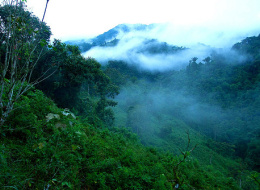
Who really holds power over land use decisions? Why are efforts to keep forests standing, such as REDD+ and other initiatives, still so far from altering development trajectories?
At the recent biennial conference of the International Association for the Study of the Commons (IASC), held in Edmonton, Canada, we presented preliminary findings of research on the politics of multilevel governance in land use change and climate policy.
Understanding the politics of land use change is challenging in part because there are so many actors involved: national and sub-national government sectors including environment, forestry, mining, and agriculture, as well as private companies, NGOs, and indigenous and local communities.
At the same time, with the increasing importance of finding new development pathways, it is ever more important to understand how these different actors work together – or in opposition – to produce land use changes on the ground.
How could we, as researchers, study this complexity and help identify viable ways forward?
CASE STUDIES IN FIVE COUNTRIES
Our solution was, essentially, to talk to as many people we could where changes were happening.
In countries like Peru and Indonesia where forests cannot be titled, we saw very different degrees and types of decentralization
We identified 54 sites of land use change in 11 regions in 5 countries – Peru, Indonesia, Vietnam, Tanzania, and Mexico – and interviewed over 700 people.
We did this at sites with low-emissions development initiatives, including but not limited to REDD+, and also in places where forests are being converted for agriculture, oil palm, mining, and other uses.
We found that despite diverse legal systems and varying levels of decentralization, powerful actors with a stake in deforestation often figure out how to get their way – whether using the rules to their advantage, or going around them.
In countries like Peru and Indonesia where forests cannot be titled, we saw very different degrees and types of decentralization, with districts empowered in Indonesia and regions empowered in Peru.
Yet in both countries actors were able to pressure the relevant government agencies – at national, regional and/or district levels – to reclassify forests as non-forests and thus open them up to private ownership and conversion.
Across countries, people we spoke to reported that coordination across sectors was a great challenge, with environmental offices and traditional sectorial offices (e.g. agriculture, mining) often working at cross-purposes.
Environmental offices at all levels were widely considered less influential than these other sectors. We believe that this reflects the broader political interests in all countries – the coalitions for agricultural expansion, mining, and traditional modes of development are either larger or more powerful than the coalition for sustainable alternatives.
NGOs and others seeking to promote more sustainable practices are left mostly talking amongst themselves.
And most low emissions efforts are trying to change the behavior of the weaker actors, sometimes reinforcing deep-seated assumptions about deforestation drivers.
REDD+: HOPE FOR CHANGE?
REDD+ has often opened some important new spaces for dialogue, as well as promoting indigenous and community rights.
In Mexico, although the forest sector is highly centralized, and more than 20 years of government policies have sought to erode the ejidos (community lands recognized under law), REDD+ has put them back in the spotlight as the custodians of 65 percent of the country’s forests.
Nevertheless, though it has brought like-minded environment sector actors together, this dialogue has not succeeded in bridging traditional sectorial divides.
Unfortunately, REDD+ is often fraught with technical jargon
Few REDD+ sites are taking on large-scale or capital-intensive drivers of deforestation, though there are cases where strengthening community rights has permitted the exclusion of unwanted outside investors.
In Tanzania, the majority of REDD+ interventions made positive efforts with sedentary farmers, but their approach excluded the weakest and poorest sectors traditionally considered problematic (often based on assumptions rather than data), like shifting cultivators and pastoralists, and failed to address problems liker farmer-herder conflicts.
Similarly, they sought to change the behavior of poor charcoal producers and other local forest users without making any effort to go after the wealthier ones driving the sector: traders and consumers.
Unfortunately, REDD+ is often fraught with technical jargon. In fact, some project proponents justify withholding information due to the complexity of REDD+ and to avoid generating expectations – but then, by definition, they are not obtaining free, prior and informed consent.
POLITICAL PROBLEMS, POLITICAL SOLUTIONS
While powerful interests are adept at working with particular government actors to achieve objectives that can threaten forests, we found that there is also hope in politics.
Critically, local governments have been key allies for conservation in some cases, with Tanzanian districts supporting the creation of village land reserves, and the district of Ketapang in West Kalimantan supporting conservation, even though oil palm is politically popular.
In Vietnam, in spite of the fact that lower level governments have little power over decision making, certain provinces and communes demonstrated far better project implementation practices.
Most notable is the case of Acre, Brazil.
Building on a history of labor union and indigenous politics, the state gradually constructed a system of environmental incentives with a broad grassroots political mandate.
This involved creating protected areas, supporting economic activities consistent with conservation like rubber tapping, and finding innovative ways to link conservation activities in the state with international support mechanisms like REDD+.
Finally, our research underlined that many of the problems facing low-emissions development are political, and they therefore require political solutions.
Political will and coalitions for change are vital for bringing about economic transformations.
Anne Larson is a principal scientist for CIFOR. Please contact Anne at a.larson@cgiar.org
Ashwin Ravikumar is a scientist at CIFOR. Please contact Ashwin at a.ravikumar@cgiar.org
We want you to share Forests News content, which is licensed under Creative Commons Attribution-NonCommercial-ShareAlike 4.0 International (CC BY-NC-SA 4.0). This means you are free to redistribute our material for non-commercial purposes. All we ask is that you give Forests News appropriate credit and link to the original Forests News content, indicate if changes were made, and distribute your contributions under the same Creative Commons license. You must notify Forests News if you repost, reprint or reuse our materials by contacting forestsnews@cifor-icraf.org.
